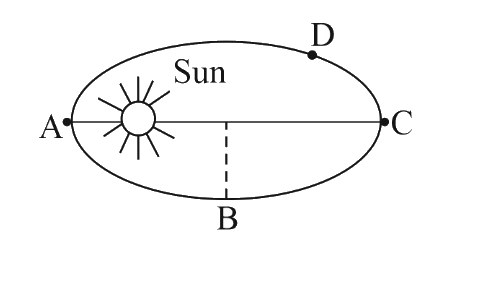A planet is revolving around the sun. its distance from the sun at apogee is rA and that at perigee is rp. The masses of planet and sun are 'm' and M respectively, VA is the velocity of planet at apogee and VP is at perigee respectively and T is the time period of revolution of planet around the sun, then identify the wrong answer.
(a) T2=π22Gm(rA+rp)3
(b) T2=π22Gm(rA+rp)2
(c) vArA=vprp
(d)vA<vp,rA>rp
The correct Answer is:C
To solve the problem, we need to analyze the motion of a planet revolving around the sun, focusing on its characteristics at apogee and perigee. We will derive relationships between the velocities, distances, and the time period of revolution, and then identify the incorrect statement among the options provided.
1. Understanding the Problem:
- The planet has two key positions in its orbit: apogee (farthest point from the sun) and perigee (closest point to the sun).
- At apogee, the distance from the sun is rA and the velocity is VA.
- At perigee, the distance from the sun is rP and the velocity is VP.
- The mass of the planet is m and the mass of the sun is M.
- The time period of revolution is T.
2. Applying Conservation of Angular Momentum:
- The angular momentum L of the planet at any point in its orbit is given by:
L=m⋅V⋅r
- At perigee:
LP=m⋅VP⋅rP
- At apogee:
LA=m⋅VA⋅rA
- By conservation of angular momentum:
LP=LA⟹m⋅VP⋅rP=m⋅VA⋅rA
- Simplifying gives:
VP⋅rP=VA⋅rA
- This implies that the product of velocity and distance is constant.
3. Analyzing Velocities:
- Since rA>rP (the distance at apogee is greater than at perigee), it follows that:
VA<VP
- Therefore, the velocity at apogee is less than the velocity at perigee.
4. Finding the Time Period:
- The gravitational force provides the centripetal force required for circular motion:
Fg=GMmr2=mV2r
- For an elliptical orbit, we can use the average distance a (semi-major axis):
a=rA+rP2
- The orbital velocity can be expressed as:
V=√GMa
- The time period T can be derived using Kepler's third law:
T2=4π2a3GM
- Substituting a:
T2=4π2GM(rA+rP2)3
5. Identifying the Incorrect Statement:
- Based on the analysis:
- Option A: Correct (relates to time period).
- Option C: Correct (relates to angular momentum).
- Option D: Correct (relates to velocity comparison).
- Option B: Incorrect (likely misstates a relationship).
Conclusion:
The incorrect statement is Option B.
- The planet has two key positions in its orbit: apogee (farthest point from the sun) and perigee (closest point to the sun).
- At apogee, the distance from the sun is rA and the velocity is VA.
- At perigee, the distance from the sun is rP and the velocity is VP.
- The mass of the planet is m and the mass of the sun is M.
- The time period of revolution is T.
- The angular momentum L of the planet at any point in its orbit is given by:
L=m⋅V⋅r
- At perigee:
LP=m⋅VP⋅rP
- At apogee:
LA=m⋅VA⋅rA
- By conservation of angular momentum:
LP=LA⟹m⋅VP⋅rP=m⋅VA⋅rA
- Simplifying gives:
VP⋅rP=VA⋅rA
- This implies that the product of velocity and distance is constant.
- Since rA>rP (the distance at apogee is greater than at perigee), it follows that:
VA<VP
- Therefore, the velocity at apogee is less than the velocity at perigee.
- The gravitational force provides the centripetal force required for circular motion:
Fg=GMmr2=mV2r
- For an elliptical orbit, we can use the average distance a (semi-major axis):
a=rA+rP2
- The orbital velocity can be expressed as:
V=√GMa
- The time period T can be derived using Kepler's third law:
T2=4π2a3GM
- Substituting a:
T2=4π2GM(rA+rP2)3
- Based on the analysis:
- Option A: Correct (relates to time period).
- Option C: Correct (relates to angular momentum).
- Option D: Correct (relates to velocity comparison).
- Option B: Incorrect (likely misstates a relationship).
The incorrect statement is Option B.
Topper's Solved these Questions
- GRAVITATIONBOOK - ALLENCHAPTER - GRAVITATIONEXERCISE - EXERCISE 2
26 Videos
- GRAVITATIONBOOK - ALLENCHAPTER - GRAVITATIONEXERCISE - EXERCISE 3
11 Videos
- GRAVITATIONBOOK - ALLENCHAPTER - GRAVITATIONEXERCISE - BOX-4
14 Videos
- GEOMETRICAL OPTICSBOOK - ALLENCHAPTER - GEOMETRICAL OPTICSEXERCISE - subjective
14 Videos
- KINEMATICS-2DBOOK - ALLENCHAPTER - KINEMATICS-2DEXERCISE - Exercise (O-2)
46 Videos
Similar Questions
Knowledge Check
A planet is revolving in an elliptical orbit around the sun. Its closest distance from the sun is r and the farthest distance is R. If the velocity of the planet nearest to the sun be v and that farthest away from the sun be V. then v/V is
AR2/r2Br2/R2CR/rDr/RA planet revolves around the sun in an elliptical orbit. If vp and va are the velocities of the planet at the perigee and apogee respectively, then the eccentricity of the elliptical orbit is given by :
AvpvaBva−vpva+vpCvp+vavp−vaDvp−vavp+va
A planet is revolving around the Sun in an elliptical orbit. Its closest distance from the Sun is r and farthest distance is R. If the orbital velocity of the planet closest to the Sun is v, then what is the velocity at the farthest point?
View SolutionA planet moves around the sun. It is closest to sun to sun at a distance d1 and have velocity v1 At farthest distance d2 its speed will be
View SolutionA planet revolves around the sun in an elliptical . The linear speed of the planet will be maximum at

View SolutionThe distance of the two planets from the Sun are 1013m and 1012m, respectively. Find the ratio of time periods of the two planets.
View SolutionThe distance of the planet Jupiter from the Sun is 5.2 times that of the Earth. Find the period of Jupiter's revolution around the Sun.
View SolutionThe distance of the two planets from the Sun are 1013m and 1012m, respectively. Find the ratio of time periods of the two planets.
View Solution

